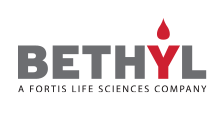NEW!
Goat anti-Human Lambda Light Chain Antibody Biotinylated

Bethyl Laboratories
Catalog #
Target:
Human Lambda Light Chain
Reactivity:
Human
Applications:
DD
,ELISA
,ICC
,IEP
,IF
,IHC
,WB
Host:
Goat
Clonality:
Polyclonal
Format:
Whole IgG
Isotype:
IgG
Conjugate:
Biotin
,FITC
,HRP
,Unconjugated
Purity:
Antigen Affinity Purified
,IgG Fraction
IgG Fraction (2 ml)
Unconjugated (1 mg)
Biotin (1 mg)
FITC (1 mg)
HRP (1 mg)
Product Details
Specifications
Verified Reactivity
Human
Antigen Species
Human
Concentration
1 mg/ml
Fluorophore/Protein
Storage
2 - 8 °C
Shelf Life
1 year from date of receipt,
2 years from date of receipt
Physical State
Liquid
Buffer
Phosphate Buffered Saline (PBS) containing 0.2% BSA and 0.09% Sodium Azide
Request Formulation Change
Phosphate Buffered Saline (PBS) containing 0.2% BSA and 0.05% Pro-Clean 400
Request Formulation Change
Phosphate Buffered Saline (PBS) containing 0.09% Sodium Azide
Request Formulation Change
Production Procedures
The antibody was isolated by affinity chromatography using antigen coupled to agarose beads and conjugated to horseradish peroxidase (HRP).
Prior to conjugation, immunoglobulin concentration was determined using Beer’s Law where 1mg/mL IgG has an A280 of 1.4. Molar enzyme/antibody protein ratio is 4:1.
By immunoelectrophoresis and ELISA this antibody reacts specifically with lambda light chains common to all human immunoglobulins. No antibody was detected against kappa or non-immunoglobulin serum proteins. This antibody may cross react with lambda light chain from other species.
Additional Product Information
The lambda light chain is a component of an Ig molecule that typically forms an Ig molecule linking to a heavy chain. The human body makes both kappa and lambda light chains, and elevated lambda levels may suggest disorders such as amyloidosis or multiple myeloma.
Applications

